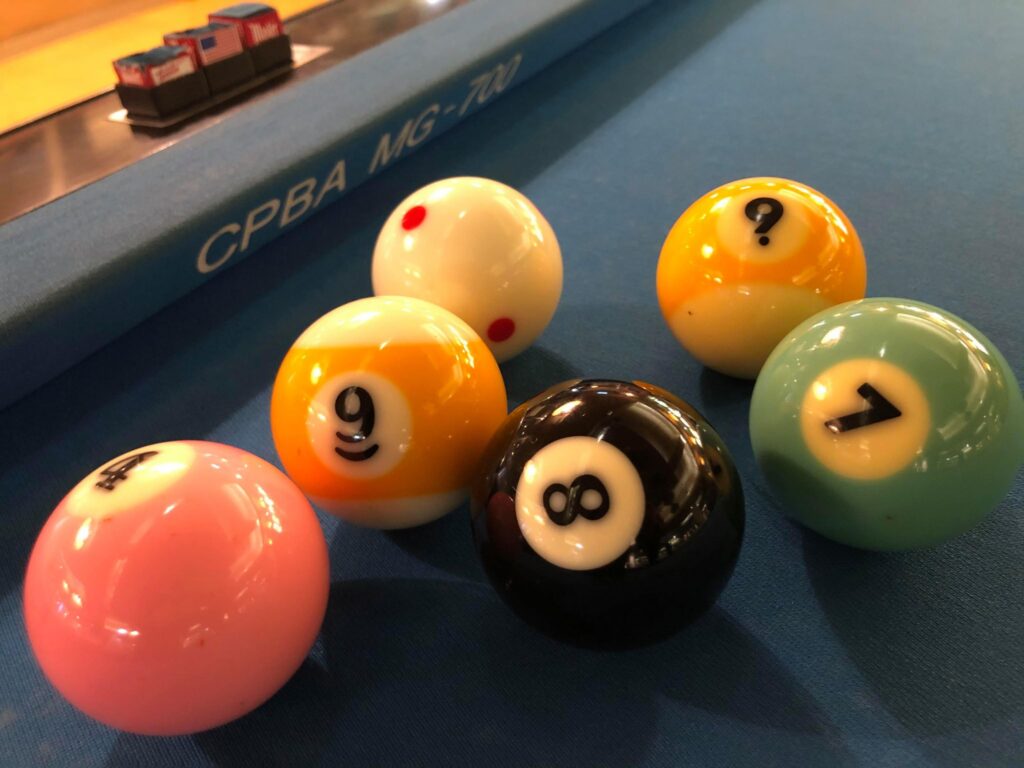This time, I would like to talk about the ball, which is an essential tool for playing billiards.
Today’s carom balls come in three colors: white, yellow, and red (the target ball), but until about 30 years ago, the hand balls were both white.
There was a black dot about three millimeters long on one side, which we called a “black ball” and the other side a “white ball” to distinguish them.
However, when it came to tournaments, it was sometimes difficult to tell from the audience’s point of view which was the white ball and which was the black ball during the game.
When the ball was first changed to yellow, there was talk among players that chalk was more likely to remain on the surface of the ball and that the course was more likely to be clogged.
I’m not sure if it’s true or not.
The ball is actually a two-layered structure with a thin coating on the outside of the hard plastic, which is the base material, but when making a yellow ball, pigment is mixed into the hard plastic.
In other words, the material was different from the white ball, albeit subtly, and that may have been the cause.
In those days, the player who won the banking game not only chose to play first or second, but also the color of the ball, and for a while, the player who won the banking game almost always chose the white ball and let his opponent play the yellow ball.
As one might expect, when Aramis, a ball manufacturer, carried out research in response to such a story, they found that yellowing the ball made the surface weaker, or some other drawback, so they improved it.
After a while, both the white and yellow balls were almost unchanged.
What’s more, the coating part of the surface was sometimes cracked while using it, but you can’t see that anymore.
Even though the accuracy of the white and black ball era was made with the best technology of the time, it was still childish compared to today.
I think that Aramis’s technology, which went from there to the robust and highly accurate products that we have today, is amazing, and I think that their attitude of always trying to research and continue to make good products, like the improvement of the yellow ball, is worthy of respect.
The world’s largest true sphere with a number of 9s in a row
Proven by scientific tests.
The “dot ball,” which has a red dot on its surface, is now familiar.
It was invented by the carom billiard community to make it easier to see the spin of the hand ball when looking at the three cushions.
To make a dot ball, combine the red sticks that serve as the dots to form a skeleton so that the six dots are evenly spread out on the surface of the ball, and then dip it in liquid plastic to solidify it.
And then we grind that mass into a round shape.
In other words, dot balls are made by combining more or less different ingredients.
Therefore, even though the holes were dug and the dots filled in and not glued on afterwards, it’s difficult to make them uniformly if you think about it normally.
But as I saw on TV before, the smallest sphere with a certain degree of sphericity (the accuracy of the roundness of the sphere) is a bearing sphere used in precision machinery.
On the contrary, the largest sphere is the billiard ball, and it’s true sphericity is almost 100%.
Aramis has the technology to do just that, and it’s because of that precision that we’re able to play so accurately without any inconvenience.
Although other companies’ balls are also used in Pocket Billiards, the majority of the balls in Carom Billiards are Aramis balls, and I think it’s no wonder.
It feels heavy.
Not a simple weight difference, but a sensory one.
But personally, when Dotball first came out, I thought it was “disgusting” (laughs).
For example, if you hit an empty cushion with a five and a half, your body will remember the points.
But with the dot, it’s like, “Hit it here! I felt like I was being instructed to do so.
The dots got in the way a bit when measuring the crests.
There was also talk of “dotball being heavier” with regular handball and dotball.
It is true that paints have different masses depending on the color, and even the same red has different masses than the one with organic and inorganic pigments.
Considering that, I don’t think it’s funny if the dot ball is heavier than a normal handball.
However, I’m sure that Aramis would have kept the difference very small, and only products that have passed various tests, such as rebound counting, are released.
Therefore, I think that the feeling of heaviness is not a simple weight difference, but a sensory one.
When the balls hit each other, they can be played at a line close to 90 degrees.
However, if you feel that the way you play the ball is different from the way you used to play it, it is not surprising that you feel that the ball of your hand is heavy.
To put it more simply, the more you use the ball, the more it rubs against the rasha and wears out from wiping.
If you compare the hand ball in that condition with the newly bought dot ball, it is of course the new dot ball that is heavier.
In other words, it was just a return to its original weight, which may have made it feel heavy.
Incidentally, ball cleaning used to use an abrasive to remove rust from copper and brass in the old days.
But with that, the ball got whittled away and got smaller and smaller, so they started using wax for cars and furniture.
In addition to these, Aramis ball waxes are now widely used.
I simply find it interesting to work with spheres.
That’s why so many people are playing with such enthusiasm.
There are many kinds of ball games in the world and they are familiar to many people.
Maybe it’s because each one is interesting, but at its core, the one thing they all have in common is “handling the ball”.
The ball has a magical power to amuse people at its root.
Babies and toddlers enjoy just rolling the ball, even if they don’t know what it means or are not very good at it.
Or you could treasure a round stone you found on a riverbank, or a crystal ball that seems mystical.
In other words, it’s not so much about what’s interesting about the ball game as it is about what makes it interesting, and I think that’s why so many people play it so enthusiastically.
I think it’s the same with billiards.
It’s not that three-cushion or nine-ball is interesting, but the joy of being able to handle the truest ball on the planet, and the delicate control of it is actually what everyone finds interesting.
Just playing the ball against the cushion should be fun enough and it should be exciting when you start out.
I’m sure there are many people who are just happy to feel the feel and sound of the toll.
So, when teaching billiards to beginners, both junior and senior players, I think it is easier to get people interested in billiards if you start by telling them how to enjoy it before teaching them how to score points.
As your career progresses and you focus only on technique and winning, you will forget the underlying joy of being with the ball.
If you are often worried about not being able to score or improve, why don’t you go back to that starting point now?




